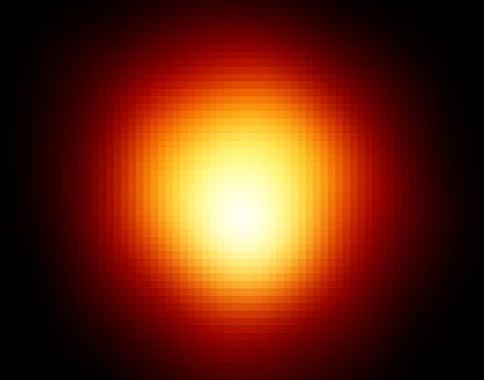
Betelgeuse: the story of a mysterious Star
14 Feb. 2020
Betelgeuse could have remained just a star among stars. On December 8th 2019, though, an unusual decrease in brightness surprised astronomers worldwide. A decrease in intensity such as this had not been measured for 25 years. Ordinary classified as the tenth brightest star in our skies, Alpha Orionis has currently dropped to the nineteenth place! Is this peculiar occurance a premonitory sign of an upcoming supernova event? Let’s recap the story of the well-known star.

The star of the stars?
Prior to the December 2019’s dimming event, Betelgeuse has been one of the most studied stars of our sky. For more than a century, astronomers have been fascinated by it and it has been compared to the rest of the stellar population in our galaxy.
Astronomer John Herschel was the first to witness the changing behavior of this star in 1836. The alternating, changing phases of brightness were later verified during the 20th century, and Betelgeuse became part of the semi-regular variable stars category: a type of star that displayed noticeable periodic intensity changes and whose cycle and amplitude vary in time. A property we will explain later in the article.
This red super-giant was not originally famous for its variable properties, which are very well-known in stellar astronomy, but for its angular diameter. Although Betelgeuse is at a distance of more than 400 light-years, its radius is about 1000 times larger than the Sun’s, which levels it up to the largest star visible in the starry sky! A superlative that was kept until 1997 when a larger angular diameter value was measured on the R Doradus star.

ALMA (ESO/NAOJ/NRAO)/E. O’Gorman/P. Kervella
A star with a large angular diameter is very interesting if we want to observe details on its surface. Whereas the majority of the stars can be considered as infinitely small dots which are impossible to view with our telescopes, Betelgeuse has an angular diameter large enough to be noticeable with optical instruments!
Moreover, Betelgeuse was the first star (other than the Sun) to get an experimental estimation of its linear diameter, carried out with the recently-invented interferometric method. To do so, physicists Albert Abraham Michelson and Francis Gladheim used the Mount Wilson observatory telescope in 1921 and ended up with an angular diameter of 0.047”.
By combining light from several telescopes to increase angular resolution in the sky, this instrumental method is now being used by the most advanced astronomical observatories of the world, such as the VLTI (Chile) and CHARA (USA).
The popularity of Alpha Orionis does not rely only on this pioneer study. Betelgeuse was once again at the forefront in 1995 when the Hubble Space Telescope unveiled the very first direct image of the surface of a star.

In recent years, a handful of images using more developed instruments and techniques were captured. In 2017, the Atacama Large Millimeter/Submillimeter Array (ALMA) provided what is still the sharpest image of Betelgeuse ever.
A strange dimming behavior
The way Betelgeuse is getting dimmer doesn’t align either with the observations that have been gathered for the past 25 years or with the most recent theoretical models. Until now, astronomers have noticed that these brightness variations between magnitudes 0.0 and +1.3 could come from two coupled phenomena:
- The first one would have a ~400-day-cycle and would be caused by the pulsation of the star’s atmosphere.
- The second, whose period is much longer – a bit more than 5 years – would be the result of the motion of huge convective cells on the surface of Betelgeuse. The latter theory is likely to be tested within few months, in response to the great interest shown by worldwide observatories towards the recent changing state of Betelgeuse.

Is Betelgeuse about to explode?
The cataclysmic phenomena of Supernovae is without a doubt fascinating for mankind due to its rarity and of the spectacular show it provides. Indeed, the most massive stars of our Galaxies like Betelgeuse should end the life releasing part of their matter in the form of luminous energy. A star with such bright intensity could be visible in a daytime sky for several weeks. The 1504 supernova from French astronomer Charles Messier’s catalog (M1) would be a historic example of a supernova humans were able to witness. The Crab Nebula was born from it.

ESO and P. Kervella
Nevertheless, today’s astronomers are not entirely convinced that a simple and progressive dimming in brightness will result in an immediate explosion of Betelgeuse. Observing light variations coming from the surface only does not necessarily contain all the information of the change that could occur inside the stellar core. Betelgeuse will very likely end up in a supernova. Even if it is currently getting dimmer, astronomers still struggle to equate this change as an indicator that could inform exactly when this explosion may occur.
Certainly no hypothesis is entirely off the mark, and professional astronomers as well as amateurs should be ready at anytime. Betelgeuse has not unveiled all its secrets yet, and could still surprise us as it has in the past. So, observe this red super-giant while it is still possible!
Photographing Betelgeuse with the STELLINA smart telescope
Betelgeuse is so bright in the sky that you can observe it in many ways: with the naked eye, using a pair of binoculars or a telescope… In order to give STELLINA‘s users the possibility of monitoring the variations in the red supergiants’ brightness, the Vaonis team added the star to its catalog of objects in its February 2020 software update (MAJ Stellinapp 1.17). Users are now invited to follow the evolution of the star over the weeks or months, in the hope of witnessing an exceptional supernova.










